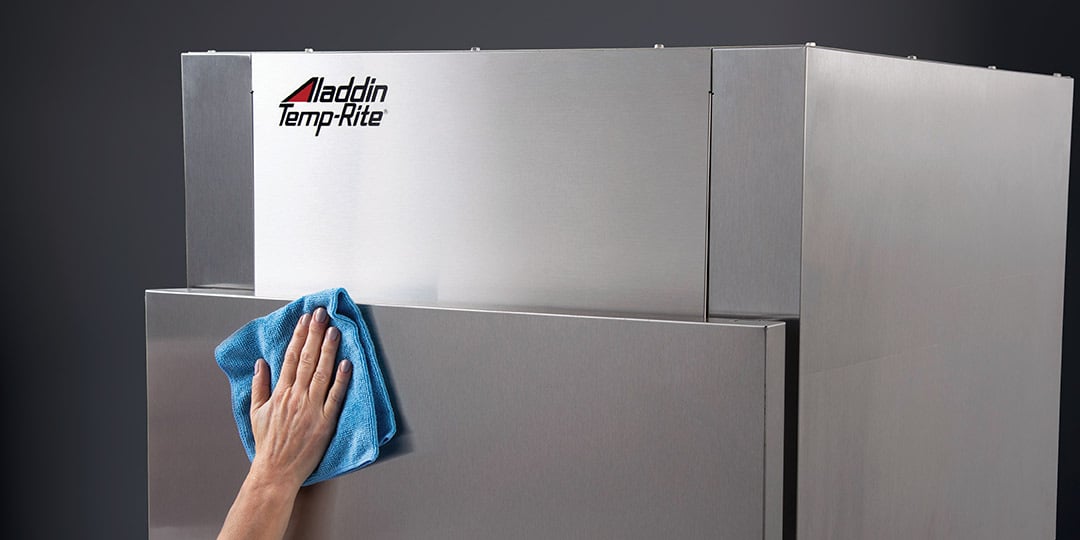Shining the Way: A Guide to Preserving Stainless-Steel in Healthcare Foodservice


Sticking to Stainless (Part 2)
Discover how proper maintenance of stainless-steel can ensure longevity and performance of your products.
The hygienic, long-lasting and seamless qualities of stainless steel make it a staple in the foodservice industry. This material is manufactured to stand the test of time, which is why it remains a popular choice compared to its counterparts. But like anything meant to last, it must be well maintained.
By properly caring for stainless-steel products, you will preserve their condition and appearance, ultimately leading to cost savings for your operation. Here are some tips for properly caring for your stainless-steel products and equipment.
How to provide a little TLC to your stainless-steel products
In healthcare foodservice, longevity matters. Choosing sturdy material that can withstand wear and tear is an important factor when determining what products will help serve patients. Stainless steel provides healthcare foodservice operations with durable, aesthetically pleasing options, making it a smart investment within the industry.
When to clean: Regularly cleaning stainless-steel products is essential to maintaining their appearance and durability. Your stainless-steel equipment should be cleaned daily to lessen the chance of abrasions. You may need to increase the frequency of cleaning if your products or equipment are heavily used or encounter stubborn stains.
How to clean: When cleaning stainless-steel products, remember these three key things:
-
Always use a soft cloth or sponge to avoid scratching the surface of the steel.
- It's important to take certain steps to prevent damage to your stainless-steel products while you are cleaning them. For example, never use abrasive cleaning products including chlorine and bleach solutions or steel wool, as these can scratch the surface of the steel.
-
Use a mild, non-chlorinated detergent or soap solution to clean the surface. Rinse it thoroughly afterward.
- To remove heavy-duty soil from your stainless-steel equipment, rub the area with a non-metallic, fine-grain scouring cloth. Be sure to rub in the same direction as the metal grain.
-
Dry the surface with a clean, dry cloth to prevent water spots.
- A stainless-steel polish can be used to shine the stainless steel and provide a protective finish that will reduce future soiling.
Pro tip: Never leave cleaning solutions on the surface of stainless-steel products for an extended period, as this can damage the steel. Always read the labels to check the ingredients of cleaning solutions or disinfectants used, as they may contain chlorinated solvents.
If you wish to gain the most out of your stainless-steel investments, you will have to ensure their upkeep. In doing so, you will maintain the material’s integrity, maximizing its resistance to corrosion. Routinely cleaning your stainless steel can add years to its life.
Oops, we didn’t maintain our stainless-steel equipment! What now?
Due to the durability of stainless steel, the material rarely deteriorates entirely, though improper maintenance can have a negative impact. Failure to properly care for stainless steel products can lead to discoloration and rust. Repeated use of chlorinated solvents may cause a chemical reaction with the stainless steel, which will damage the surface finish and cause corrosion. Not only does this affect the appearance of stainless-steel products, but it can also reduce their lifespan.
Prevention is key. It's advisable to avoid prolonged exposure to moisture and acidic substances, as they can accelerate rust formation on stainless-steel. If you encounter stubborn rust, commercial products formulated specifically for stainless-steel can be utilized. Regular inspections and repairs of any scratches or damage on stainless-steel surfaces are vital to preventing rust and discoloration.
Maintaining your stainless-steel products is crucial for preserving their longevity and ensuring optimal performance in healthcare foodservice operations. By following proper cleaning techniques and avoiding abrasive materials, you can protect the appearance and durability of stainless steel, resulting in cost savings for your facility. Healthcare foodservice professionals can worry less about the quality of their products and equipment and more about creating an exemplary patient experience. Taking proper care of your stainless-steel products will ensure they look great and perform well for years to come.




